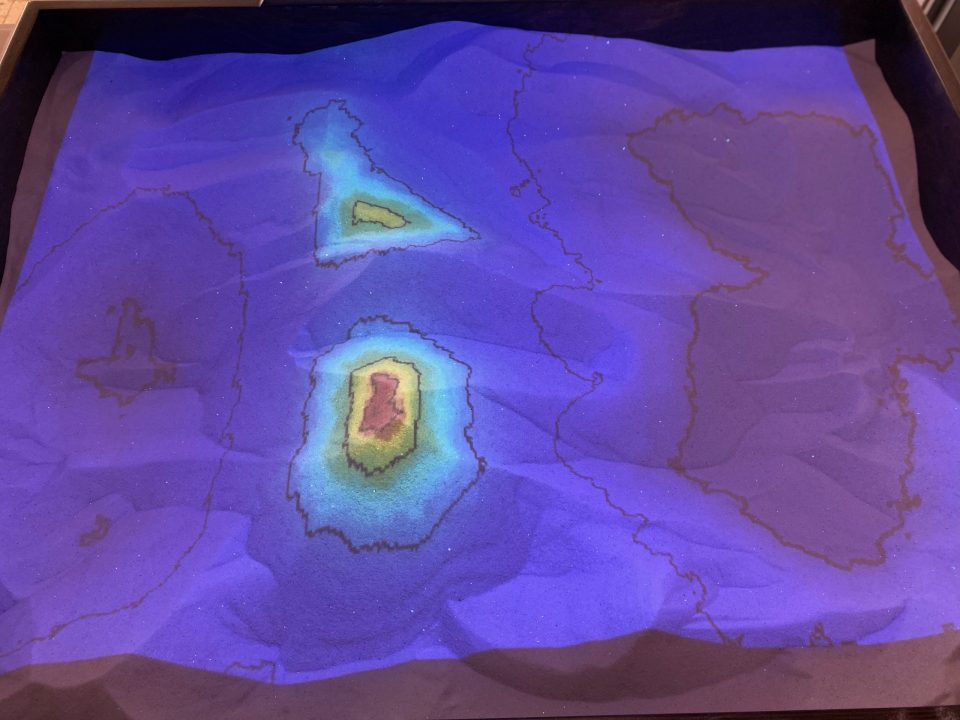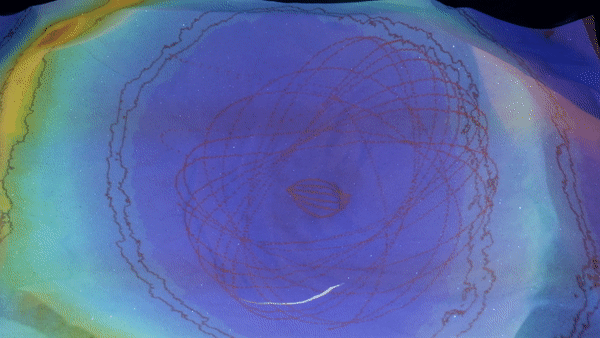Exhibits
Gravity Box
In 1915, Albert Einstein finalized the development of the theory of general relativity. This was a description of how gravity worked by using the geometry, or shape, of space and time as the stage in which objects can move and interact with. This told us that geometry, how space itself was bent and warped, could determine how planets and particles will move through space – along with predicting black holes and other exciting observations!

In this exhibit, gravitational forces have been modelled with a sandy terrain. The screen above is reading out a map of the hills and valleys that are shaped by the sand and calculates how a particle will move across this hilly terrain. Try it out for yourself! Move the sand around how you want, creating dips and sharp peaks in different locations. The colours tell you about the relative height and sharpness of the terrain: the higher and pointier an area of sand is, the more it will progress from blue, to yellow, to red. Once the computer calculates the shape of your landscape, use the mouse to drag a particle into existence: click to add, pull back to give the particle some speed, and click to release. Now watch your particle interact with your landscape! Notice how it slows down going up a slope, or speeds up going into a valley, or how its trajectory changes paths as it crosses some hilly portion!

Can you get a particle to closely oscillate back and forth between two hills? What about orbit around a central hill?
This is how particles and objects move through the universe, interacting with the shape of space due to different objects like stars and planets having a gravitational influence! The Sun interacts with Earth through this process, keeping it in orbit and spiralling continuously. The same is true for comets around the Sun, the Moon orbiting Earth, the Sun around the center of the Milky Way galaxy, and all large scale extragalactic motions too!
[expand title=”Teacher Resource – Curriculum Connections”]
Ontario Grade 9 Science (SNC1W)
The Sun as influencer :
E2.1 – describe the importance of the Sun and its characteristics, including its role in the solar system and in sustaining life on Earth
Observational astronomical phenomena :
E2.6 – conduct investigations to explain the causes of various astronomical phenomena that can be observed from Earth
Ontario Grade 11 Physics (SPH3U)
Gravitational field, force, mass :
C3.4 – describe, in qualitative and quantitative terms, the relationships between mass, gravitational field strength, and force of gravity
Ontario Grade 12 Physics (SPH4U)
Gravitational fields, energy, potential energy :
D2.1 – use appropriate terminology related to fields, including, but not limited to: forces, potential energies, potential, and exchange particles
Laboratory inquiry particle in gravitational field :
D2.5 – conduct a laboratory inquiry or computer simulation to examine the behaviour of a particle in a field
Standard Model and General Relativity :
D3.1 – identify, and compare the properties of, fundamental forces that are associated with different theories and models of physics (e.g., the theory of general relativity and the standard model of particle physics)
Ontario Grade 12 Earth and Space Science (SES4U)
Inquiry – General Relativity advancing knowledge :
B1.1 – analyse a major milestone in astronomical knowledge or theory, and explain how it revolutionized thinking in the scientific community
Newton’s laws and planetary motion :
C3.8 – identify Newton’s laws, and use them to explain planetary motion
[/expand]
